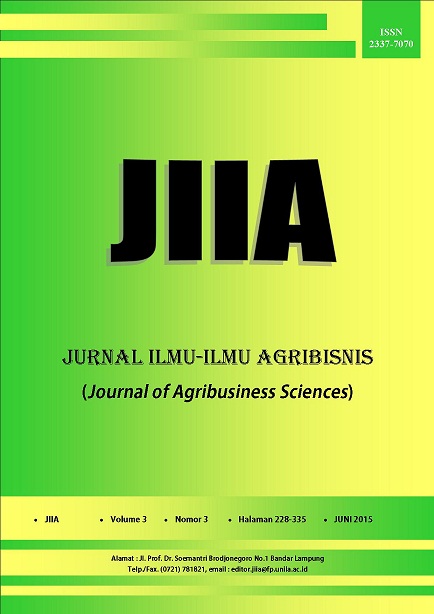PROYEKSI PRODUKSI DAN KONSUMSI TELUR AYAM RAS DI PROVINSI LAMPUNG
DOI:
https://doi.org/10.23960/jiia.v3i3.1053 Abstract View: 1605
Abstract View: 1605
Abstract
Poultry egg is one of the important animal protein resource. Consequently, their availability in a society has to be predicted for several years. In Lampung Province, the local government forecasts the poultry egg production just for one year. It causes the production of poultry egg, as well as their availability, is unknown for long term. Therefore, the aim of this study is to project the production and to project the consumption of the poultry egg. Both projections are compared in order to know its sufficiency. The prediction was done by the ordinary least square method with the time series data 2000-2013. The result showed that the average product (AP) was 16.75 kgs/head/year. However, during the epidemic of the avian infulenza (2003-2007), the AP had been decreasing, i.e. 15.99 kgs/head/year. The poultry egg production in 2013 was 51.39 thousand tons and the average growth rate was 3.64% per year. Meanwhile, the poultry egg consumption of Lampung Province in 2013 was 51.33 thousand tons and the average growth rate was 2.48% per year. Since the growth rate of production is higher than the growth rate of consumption, the production will be larger than the consumption starting in 2026.
Key words: consumption, poultry egg, production, projection
Downloads
Downloads
Published
How to Cite
Issue
Section
License
Authors who publish with this journal agree to the following terms:
Authors retain copyright and grant the journal right of first publication with the work simultaneously licensed under a Creative Commons Attribution License that allows others to share the work with an acknowledgement of the work's authorship and initial publication in this journal.
Authors are able to enter into separate, additional contractual arrangements for the non-exclusive distribution of the journal's published version of the work (e.g., post it to an institutional repository or publish it in a book), with an acknowledgement of its initial publication in this journal.
Authors are permitted and encouraged to post their work online (e.g., in institutional repositories or on their website) prior to and during the submission process, as it can lead to productive exchanges, as well as earlier and greater citation of published work (See The Effect of Open Access).














